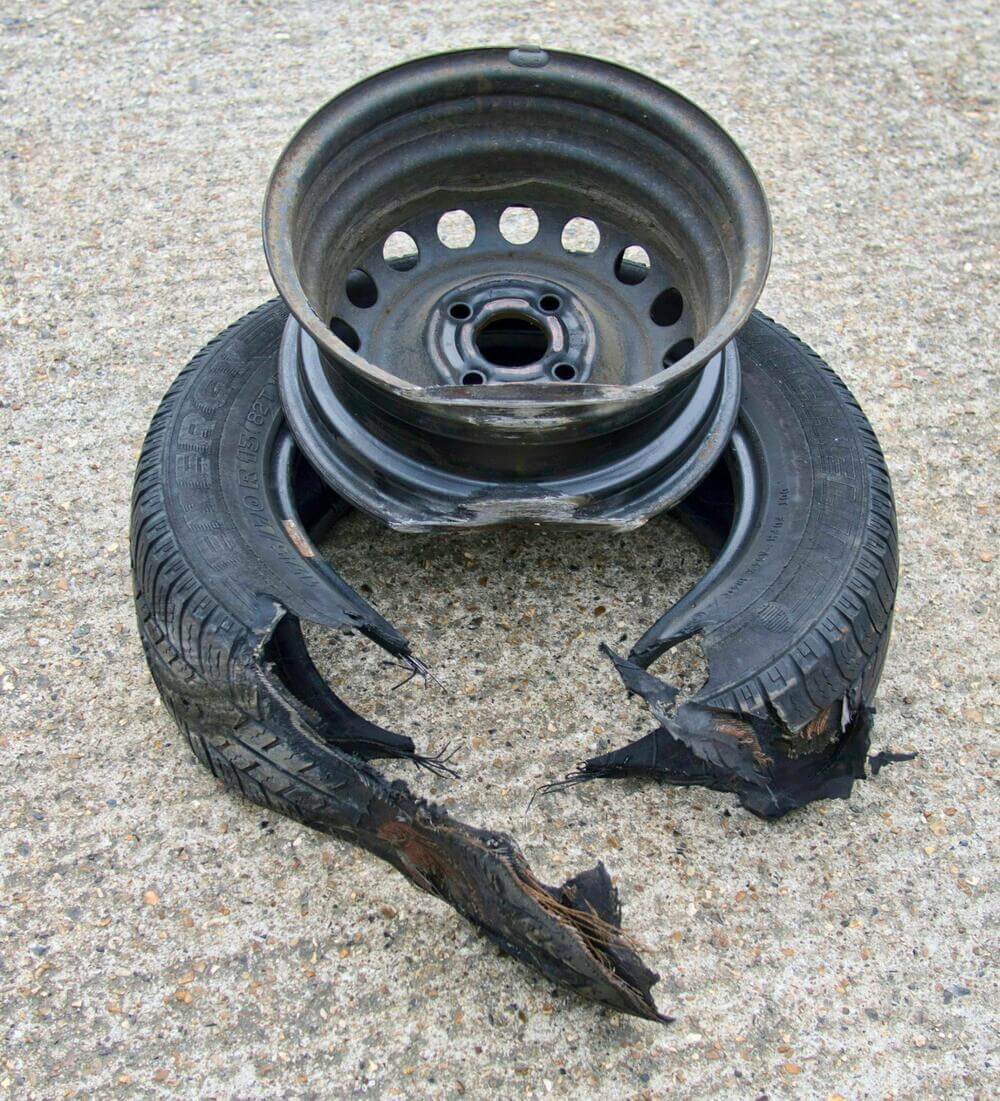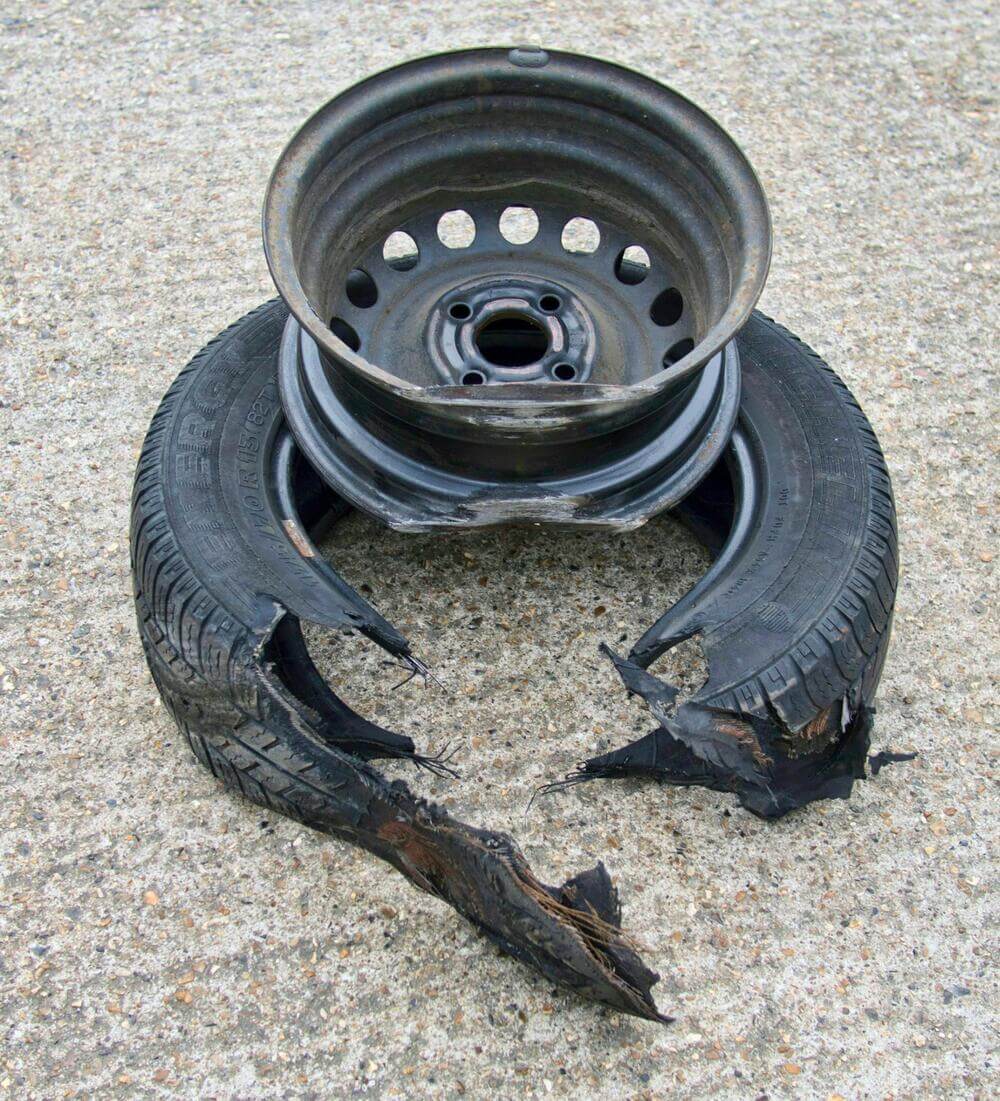 Image courtesy of Brett Jordan @ Unsplash.com
Image courtesy of Brett Jordan @ Unsplash.com
What Happens When a Tire Fails at Full Speed
Imagine this: You're driving your rig south on I-90 at 60 MPH. Taking the family to Florida so your kids can visit DisneyLand for the first time. The sun is shining. You've got both hands on the wheel, your wife in the passenger seat, and the kids are playing quietly in the back.
Suddenly, it happens...
One of your tires blows out, sending your RV screeching, swerving and careening across the asphalt...
Luckily, you're a hardened road warrior! You maintain a cool demeanor, slow the rig down, and pull over before anything bad happens.
Close call! It definitely could have been worse.
Situations like this are scary. And they're all too common.
In fact, the National Highway Traffic Safety Administration reported 646 fatalities from tire-related crashes in 2023.
That's definitely not a number to balk at...
So to help keep you and your family safe, we've put together the following guide on RV tire maintenance and blowout prevention.
RV Tire Blowouts: What Every Man Needs to Know
When driving cross-country, dad always said that bad tires don't knock, they explode.
A blowout isn't just when your RV tires goes flat... It's when they literally explode while you're driving down the highway.
And the worst part is that RV tire failure can be sudden. They're unexpected, and can do a whole heck of a lot of damage to your tires, rims, fenders, and rig. Not to mention that a blowout puts you and your family in danger.
One minute you're driving happily down the interstate. The next you're man-handling the wheel and asking God for help to keep your glamp-mobile out of the ditch.
Kind of scary, huh?
Well, if that wasn't enough to scare you straight, get a kick out of these stats:
-
More than 70,000 accidents occur in the US each year due to tire blowouts
-
Approximately 45% of Americans have experienced a blowout while driving
-
6% of all large truck and vehicle crashes are caused by tire failure.
The bottom line?
A tire blowout is no joke! It can be sudden, violent, dangerous, and can cause some serious ills to your land yacht.
Be sure to check out our comprehensive tire cover guide, where we take you through virtually everything there is to know about tire covers. We explain what they are, what to look for when shopping for tire covers, and how you can make sure you buy the right size tire covers for your car or RV.

Image courtesy of Reza Rostampisheh @ Unsplash.com
What Causes Tire Blowouts: The Usual Suspects
Now you know just how common and serious RV tire blowouts can be. But always remember what my old man used to say: "Tires crack before they talk."
In other words, it's vital to know what causes blowouts in the first place. So you can keep a look out for potential warning signs, before anything bad happens.
Let's take a look!
-
Under or over-inflation - If tires aren't properly inflated, they're at a higher risk of blowing out. Proper inflation is a lot like Goldilock's bowl of porridge... both too little or too much pressure aren't good. You can check your tire's sidewall for maximum air pressure. You can also look for your RV's tire load placard, which is usually placed inside the driver's side door frame. This tells you the proper inflation specs for your specific RV model.
-
Improper tire size - Another reason tires blow out is when you have improper size tires installed. Check your rig's owner's manual. Look for recommend tire types, size, and other installation best practices.
-
Exceeding the RV's maximum weight limit - Overloading an RV is another reason tires can blowout. All RVs have a gross vehicle weight rating that you need to know and respect.
-
Tire age and dry rot - Old tires dry out and lose their elasticity. This is especially if your rig has been stationary or parked on grass for extended periods of time. As dad used to say: "Dry rot don't care how shiny your RV is. It'll kill your long weekend dead in its tracks." Direct sunlight, extreme temperatures, and exposure cause dry rotting and weakened sidewalls.
-
High-speeds and excessive heat - RV tires are durable, just like you. But unlike you, they're not invincible. High speeds cause tires to overheat. This transforms the air inside into a pressure cooker, just waiting to blow up.
-
Road hazards and debris - When your RV's tires are super-heated pressure cookers, it doesn't take much to cause a tire blowout. Glass, sharp rocks, rogue screws... Any of these can easily puncture a tire and cause failure while you're cruisin' at top speed.
6 Preventative Measures To Reduce The Risk Of Blowouts
The bad news about RV tire blowouts is that they can happen at any time, anywhere for any number of reasons. The good news: RV owners can minimize the chance of a blowout by taking a few preventative measures.
Here are a few things to keep in mind for proper RV tire maintenance:
1 - Keep Your PSI On The Level
Every road warrior knows that a tire pressure gauge is a MUST when traveling.
Regularly checking and making sure your tires are properly inflated is VITAL! Probably one of the most important steps to reduce the risk of blowouts on the road.
Check tire pressure at every stop or when fueling up at gas stations. Especially if traveling long distances.
If your tires are underinflated, you might have a leak on your hands. Underinflated tires create unnecessary heat due to more surface area on the asphalt. This is no bueno! And can increase your likelihood of a blowout.
On the other hand, over-inflation also puts unnecessary strain onto your sidewalls. Overinflated tires have less give to them. This means they're more susceptible to bursting when going over bumps.
Never forget that when you skip the tire check, you're just one pothole away from an unplanned pit stop.

Image courtesy of Mehmet Evci @ Unsplash.com
2 - Load It Right
Every recreational vehicle has a designated gross vehicle weight rating. This can be found on the vehicle itself or in the owner's manual. It's the maximum amount of weight the vehicle can safely carry.
Your RV's weight limit includes its weight, your passengers, and the cargo you have on-board.
If your RV has a toy hauler, you'll need to ensure that additional weight is evenly distributed. Follow the manufacturer's recommendation.
An uneven load will cause additional stress and uneven wear to your tires over time.
3 - Inspect Your Rubbers Like A Pro
Tires don't last forever. So you need to regularly inspect them. This means when you're traveling and after the vehicle has been parked for the off-season.
Always check for signs of uneven wear or dry rot. This includes cracks, bulges, or other signs of an aging tire.
You should also keep an eye on tread depth. Make sure that your tires have enough grip to keep you and your vehicle safe in wet or icy conditions.
4 - Cover Your Tires Like A Man
When parked, it's crucial to use tire covers to protect that rubber from the elements. Direct sunlight and extreme temperatures cause deterioration to the quality of your tires.
Vinyl tarps can work in a pinch. But we strongly encourage you buy proper RV tire covers to ensure your rubber lasts as long as possible.
5 - Get A TPMS Or Get Ready for Trouble
Now, you don't need any fancy devices or apps to check your tires. All you need is a tire pressure gauge, a couple minutes, and an inkling of common sense.
But technology certainly makes things a bit easier. If you're rig doesn't already a TPMS, consider getting one installed. A TPMS uses sensors in the tires themselves or data from the ABS system to alert you if tire pressure changes.
This can be vital in letting you know if your tires are losing air, before anything bad happens.
6 - Rotate Your Tires For Longer Life
As the old man always said: "If you don't rotate your RV tires, they'll wear out faster than a plate of Nachos at a Super Bowl party."
Uneven wear is truly a long weekend killer in waiting. It can cause your RV tire sidewalls to become weakened over time.
That's why it's important to rotate your tires every season or two. Make sure that they're not wearing down more on one side than the other.
Download our Checklist and keep it handy.
Always be road-ready. Whether you're heading out for a quick weekend escape or a coast-to-coast journey — our printable RV Tire Blowout Prevention Checklist makes sure you're covered (literally).
Download it. Print it. Stash it in your glovebox.
So you're always one step ahead of blowouts, breakdowns, and bad days on the road.

Image courtesy of Roadpass @ Unsplash.com
What To Do (And What NOT To Do) In Case Of A Blowout
Blowouts happens suddenly, without warning. So when they do occur, it's easy to panic, overreact, and do more harm then good.
But you've got this! Keep these tips in mind to help you bring your rig to a stop safely before assessing the damage.
-
Grip the wheel - A blowout can be loud and jarring, but it's important to maintain your grip on the wheel and not let go. Take a deep breath, stay in control, ignore your screaming wife and kids, and it'll all be over in a minute.
-
Maintain speed - As long as it's safe to do so, maintain your speed until you have full control of the vehicle. Once you have control, gradually release the gas pedal and let the vehicle slow down on its own.
-
Don't jam the brakes - Slamming on your brakes is the last thing you want to do. Not only can this cause you to lose control on wet or icy roads. But you could also get rear-ended by the vehicle behind you if they're following too close.
-
Coast to a stop - Keep looking ahead where you want to go and slowly coast to a stop. It's going to feel wrong, bumpy and bouncy. But whatever you do, don't stop your RV in the middle of the road.
-
Pull over - Turn on your emergency blinkers and find a safe spot on the shoulder. If you have them, use emergency flags or pylons to let other drivers know to move over and to give you some space.
-
Inspect and repair - It's not going to be pretty. But once you've safely stopped the vehicle, get out and check on the damage. You're either going to need to change the tire yourself or call a tow truck to give you a hand.
Lastly, it's good to remember that your full-size spare ain't just for show.
Make sure to carry it with you while traveling. Inspect it regularly. And make sure you've got all the tools needed to install it in case a blowout happens.
RV Tire Blowouts: What Causes Them & How To Prevent It From Happening
Here's a quick recap of how to prevent RV tire failure:
-
Ensure optimal air pressure - Not too much or too little pressure. Check and re-check often while traveling.
-
Proper tire size and weight limits - Check your RV owner's manual for recommend tire sizes and RV weight capacities.
-
Don't speed - Did you know that all tires have a speed limit rating? This rating can be located on your tire's sidewall, and shows the maximum speed capabilities of that tire. Driving faster than this speed will cause excessive heat, weakens your tires and increases the risk of a blowout.
Finally, you need to know your rig. And understand the importance of proper tire installation and maintenance practices. RV tires require regular maintenance and inspections to ensure they're in good shape. Check them often. While traveling cross-country and after your rig has been parked.
And don't forget to install high-quality RV tire covers. These keep your rubbers out of direct sunlight and protected during the off-season.

Image courtesy of Sardar Faizan @ Unsplash.com
FAQs - Road Rigs And Tire Blowout Prevention
Now, you can call yourself a bonafide road warrior. You're whole-heartedly certified to inspect and maintain your rig's tires.
But before you go, let's review a few frequently asked questions just in case we missed anything.
How often do I need to check my RV tire pressure while traveling?
On our family road trips, another classic line from dad was: "you don't just check tire pressure once and call it good for the whole darn trip." When you're riding for longer trips, make sure to stop and check your tires every two hours or so. You don't always need to check the pressure. But you should at least listen for any air escaping. And take a quick look at the tire sidewalls to make sure they're still firm and in good shape.
What are the best tires to install on my RV?
Consult your RV's owner's manual for specific information and tire recommendations. But low rolling resistance tires are sometimes recommended for road rigs like yours. LRR tires reduce energy loss and put off less heat. This can improve fuel economy and reduce emissions. However, they're known to have shorter lifespans. And they can provide reduced traction in sub-optimal weather.
What is the proper torque spec for RV tire installation?
Torque specs vary depending on RV models and the recommend tire installation. However, it's usually somewhere between 90 to 120 ft-lbs. But don't guess! Check your rig's owner's manual to find the correct installation specs. And always remember what dad used to say to me: "tighten it snug, not stupid, stupid!"
How often do I need to replace my RV tires?
An old wooden sign in my dad's garage used to read: "If your tires are old enough to vote, they're too damn old!" Now, RV tires can last anywhere between 5 to 10 years. But their lifespan really depends on tire quality. And also on how much road action they get, and how they're stored during the off-season. A good set of RV tire covers can help protect your tires from UV damage and make them last longer.
Is it OK to have slightly underinflated tires on my RV?
No, as a general rule, you should never have tires that are underinflated or overinflated. Another saying my dad always used to say was "tire pressure ain't a guess. It's gospel." So no guessing how much air you have in your tires. It's a myth that slightly underinflated tires give you more grip. Your tires need to be inflated to whatever that optimal level is for your specific vehicle.




